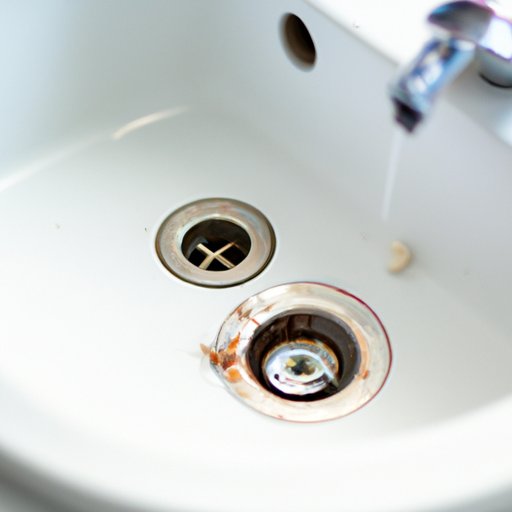Introduction
A clogged kitchen sink is a common issue, which can be caused by anything from food debris to soap build-up. If you’re struggling with a stubborn clog, don’t panic! With the right tools and resources, you can easily unclog your kitchen sink with minimal fuss. This article will provide you with a step-by-step guide on how to unclog your kitchen sink and offer tips on how to prevent future clogs.
Step-by-Step Guide
Before you get started, you’ll need to identify the cause of your clog. Common causes include leftover food, grease, soap build-up or a foreign object lodged in the drain. Once you’ve identified the issue, there are several methods you can use to unclog the drain:
- Plunger: This method works best for small clogs. Fill the sink halfway with water, place the plunger over the drain, and pump up and down vigorously to create suction. Repeat until the water begins to drain.
- Removing the trap: If the clog is caused by food or grease build-up, you may need to remove the trap under the sink. Place a bucket underneath to catch any debris and then unscrew the nuts holding the trap in place. Clean the trap thoroughly before reassembling.
- Plumbing snake: This tool can help break up stubborn clogs. Insert the snake into the drain and turn the handle clockwise, until it becomes difficult to turn. Reverse the motion and repeat until the clog has been broken up.
When unclogging your sink, it’s important to take precautions to avoid causing any damage. Before attempting any method, ensure that you have the necessary safety equipment, such as gloves or goggles, in case of splashes or corrosive chemicals.
Home Remedies
If you prefer natural methods, there are several home remedies you can use to unclog your kitchen sink:
- Baking soda and vinegar: Pour half a cup of baking soda down the drain, followed by half a cup of vinegar. Cover the drain and let the mixture sit for 15 minutes. Flush the drain with hot water.
- Hot water: Boil a pot of water and pour it slowly down the drain to help break up build-up and flush debris out of the pipe.
- Saltwater mixture: Combine half a cup of table salt with boiling water and pour it slowly down the drain. Let the mixture sit for several hours before flushing with hot water.
Be cautious when using home remedies, as they may not be effective for severe clogs. Additionally, some remedies involve the use of corrosive substances that require safety precautions to avoid damage to your skin, furniture, or carpet.
Commercial Products
If natural methods fail to unclog your sink, commercial products can be effective in tackling stubborn clogs. Here are a few to choose from:
- Clog removers: Available in liquid or gel form, these products work by dissolving or breaking down the clog. Follow the instructions on the label carefully, taking care to rinse the drain with hot water after use.
- Plumbing snake: If you don’t already have one, a plumbing snake can be purchased from a hardware store. Choose a product that is compatible with your sink type and follow the instructions carefully to prevent damage to pipes.
- Hydrogen peroxide: Hydrogen peroxide can help dissolve organic matter. Carefully pour a small amount of hydrogen peroxide down the drain, followed by hot water, and wait several hours before checking if the clog has cleared.
Be cautious when using commercial products, as they may contain chemicals that require the utmost care when handling. Store them in an area that is strictly inaccessible to children and pets. Also be sure to use the appropriate product for your specific type of pipe to prevent corroding your plumbing.
Prevention Tips
Prevention is key when it comes to avoiding future clogs in your kitchen. Here are a few tips to keep in mind:
- Sink strainer: Invest in a sink strainer to prevent food debris, grease, hair, and other items from going down the drain.
- Garbage disposal: Avoid putting large amounts of food, oils, and grease down your garbage disposal. Instead, opt for mulching smaller pieces and flushing with hot water.
- Regular maintenance: Clean your sink regularly to prevent build-up of debris, and run hot water down the drain regularly to clear out any clogs that may be forming.
When to Call for Help
If none of these methods work, or if the clog becomes too large, it’s time to call in a professional. A plumber will have the expertise and equipment to diagnose and fix the problem quickly and safely. Be prepared to answer questions from the plumber about the severity and location of the clog when you call them. Remember, investing in regular cleaning and inspections can save money and prevent costly repairs and damage to your property.
Conclusion
Clogged sinks can be an irritating and stressful problem. But with a little patience and the right tools, you can easily unclog your kitchen sink. Remember to be cautious when using different methods, and take care to prevent further clogs with regular sink maintenance. If all else fails, don’t hesitate to call in a professional plumber to take care of the problem for you.
